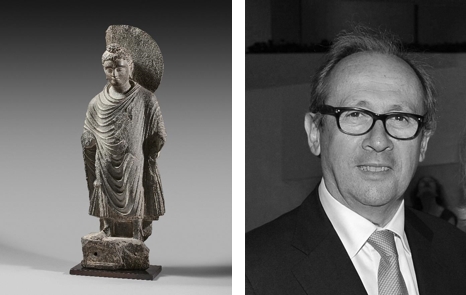

The Art of Gandhāra

29/01/2021
By Christophe Hioco, Galerie Hioco (Paris)
TALK given in French - Watch the talk HERE
The Christophe Hioco Gallery specializes in the ancient statuary art of India and the Indianized world, including Southeast Asia and the Himalayas. The gallery's selection criteria are as rigorous as those of the greatest museums and great attention is paid to the originality, quality, provenance and authenticity of each pieces. This uncompromising approach to the artworks acquired have enabled the gallery to develop trusting relationships with the world's greatest collectors and museums. The gallery has participated for many years in major Asian art events: the Biennale Paris and the Parcours des Mondes in Paris, the BRAFA in Brussels and Asia Week in New York. The Christophe Hioco Gallery is also a member of the S.N.A. (Syndicat National des Antiquaires Négociants en Objets d'Art Tableaux anciens et modernes de France), the ROCAD.be and the Asia Week New York Association, Inc.
The Gandhāra Valley and its extensive surrounding territories are the cradle of an original art style largely inspired by Helleno-Roman and Parthian art, adapted for Indian religions, almost exclusively Buddhism. In discussing its origins, we must go back to the adventures of Alexander the Great in Central Asia, up to the very gates of India (330-326 B.C.E.) and to the founding of Greek colonies such as Ai-Khanoum on the Oxus (Amu Darya), located on the modern border between Afghanistan and Tajikistan.
The caravan trade helped spread Western influences, even if the genesis of the synthetic art of these regions retains some obscure aspects. It developed over a vast area, from the Muslim republics of Central Asia up to the north of Pakistan. Many regional styles co-exist. Documentation from the 1st century B.C.E. is rare and inconclusive. The apogee of this art, formerly called “Greco-Buddhist” art, an incorrect but image-evoking description, dates from the 2nd or 3rd century of our era. Beautiful works were created one after the other until Islam arrived at a point in time that varies depending on the region concerned.
Standing Buddha, Schist, Ancient region of Gandhāra, circa 3rd century, H 67 cm
TALK given in French - Watch the talk HERE
The Christophe Hioco Gallery specializes in the ancient statuary art of India and the Indianized world, including Southeast Asia and the Himalayas. The gallery's selection criteria are as rigorous as those of the greatest museums and great attention is paid to the originality, quality, provenance and authenticity of each pieces. This uncompromising approach to the artworks acquired have enabled the gallery to develop trusting relationships with the world's greatest collectors and museums. The gallery has participated for many years in major Asian art events: the Biennale Paris and the Parcours des Mondes in Paris, the BRAFA in Brussels and Asia Week in New York. The Christophe Hioco Gallery is also a member of the S.N.A. (Syndicat National des Antiquaires Négociants en Objets d'Art Tableaux anciens et modernes de France), the ROCAD.be and the Asia Week New York Association, Inc.
The Gandhāra Valley and its extensive surrounding territories are the cradle of an original art style largely inspired by Helleno-Roman and Parthian art, adapted for Indian religions, almost exclusively Buddhism. In discussing its origins, we must go back to the adventures of Alexander the Great in Central Asia, up to the very gates of India (330-326 B.C.E.) and to the founding of Greek colonies such as Ai-Khanoum on the Oxus (Amu Darya), located on the modern border between Afghanistan and Tajikistan.
The caravan trade helped spread Western influences, even if the genesis of the synthetic art of these regions retains some obscure aspects. It developed over a vast area, from the Muslim republics of Central Asia up to the north of Pakistan. Many regional styles co-exist. Documentation from the 1st century B.C.E. is rare and inconclusive. The apogee of this art, formerly called “Greco-Buddhist” art, an incorrect but image-evoking description, dates from the 2nd or 3rd century of our era. Beautiful works were created one after the other until Islam arrived at a point in time that varies depending on the region concerned.
Standing Buddha, Schist, Ancient region of Gandhāra, circa 3rd century, H 67 cm